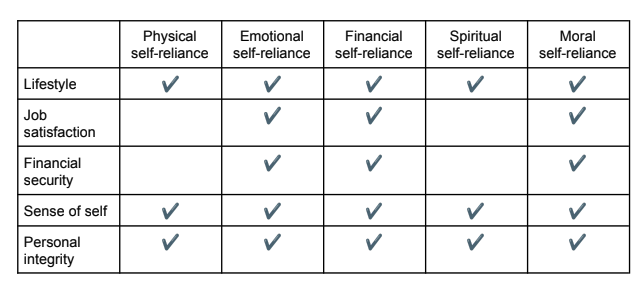The Self-Reliance Matrix

The Revival of Protectionism and Australian Manufacturing.
December 17, 2020
The 5 Pillars of Self-Reliance
October 3, 2023The Self-Reliance Matrix: a tool to evaluate and motivate.
What is a self-reliance matrix?
A self-reliance matrix is a tool that can help individuals, in this case young people, assess their level of self-reliance and identify areas for improvement. The matrix will list the Five Pillars of Self-Reliance and the various skills or qualities associated with them.
The Five Pillars include:
1. Lifestyle
2. Work satisfaction
3. Financial security
4. Sense of self
5. Personal integrity
Individuals will be able to gauge their current level in each area and set goals for improving their self-reliance in areas where they need to grow. The self-reliance matrix will be useful for individuals who want to become more self-sufficient and independent, as well as for educators, mentors, and coaches who work with young people and want to help them develop these important life skills.
In addition, a self-reliance matrix based on these five factors can help individuals identify any interdependencies or relationships between these areas. For example, a lack of financial security may impact an individual's lifestyle and sense of self, which in turn can affect their work satisfaction and personal integrity. By recognising these connections, individuals can develop a more comprehensive plan for improving their self-reliance.
Overall, the purpose of a self-reliance matrix is to provide individuals with a tool for assessing and improving their self-sufficiency in key areas of life, leading to greater independence, self-confidence, and personal fulfilment.

How can the self-reliance matrix help achieve behavioural change?
A self-reliance matrix can help achieve behaviour change in several ways:
1. Self-awareness: The process of filling out a self-reliance matrix requires individuals to take a critical look at themselves and assess their current level of self-reliance. This self-awareness can help individuals recognize areas where they need to improve and motivate them to take action.
2. Goal setting: A self-reliance matrix allows individuals to set goals for improving their self-reliance. These goals can help individuals focus their efforts on the areas that need improvement and give them a clear target to work toward.
3. Tracking progress: A self-reliance matrix allows individuals to track their progress over time and monitor their improvement. Seeing progress can be a powerful motivator for continuing to work toward a goal.
4. Accountability: Sharing the self-reliance matrix with a teacher, mentor, coach, or friend can provide a level of accountability that can help individuals stay on track with their goals.
5. Action planning: A self-reliance matrix can help individuals develop an action plan for achieving their goals. By breaking down their goals into smaller, achievable steps, individuals can create a roadmap for behaviour change.
If the goal of building up the inner resources of today’s youth by teaching them self reliance resonates with you, we would love to hear from you.




